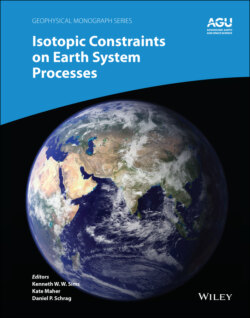Читать книгу Isotopic Constraints on Earth System Processes - Группа авторов - Страница 52
2.3. RESULTS 2.3.1. Major Element Diffusion Profiles
ОглавлениеMajor‐element diffusion profiles from two experiments that differ in duration (2.5 versus 6 hours) are shown in Fig. 2.3. Note that the x‐coordinates of both profiles have been shifted such that the phonolite‐rhyolite interfaces overlap and the profiles are framed within each panel. Additionally, in the 6‐hour experiment the capsule was loaded with more phonolite powder (0.07 g) than rhyolite powder (0.04 g), and consequently, the rhyolite side of the couple is short, occupying only about one‐third of the capsule length.
The major element profiles exhibit features that are interesting, although we cannot fully explain some of them. We observe uphill diffusion (i.e., diffusion of a component against its own concentration gradient) in all the major‐element oxides, including SiO2. The SiO2 and Al2O3 profiles change relatively little from the starting materials, which is expected because of the low diffusivities of these components and the coupling between Si and Al in the silicate framework components of the liquids. One thing that is unexpected is that the absolute concentrations of SiO2 and Al2O3 on the rhyolite end of the profiles are low relative to the starting values. This should be regarded as an analytical inconsistency as it cannot be explained by a dilution effect. The absolute concentrations of Na2O are even more problematic, being too high relative to the starting materials. The simplest explanation is that the starting materials actually had Na2O concentrations that were about 0.5% higher than reported. This is unexpected, but possible, since it is well known that Na can be volatilized during EMP analysis, leading to incorrectly low measured concentrations. These issues do not significantly affect the main conclusions that we draw from the Ca and K isotopic results.
A notable feature of the data is the dramatic rearrangement of the Na, Ca, and K components in the 2.5 hour run. The K profile is strongly affected by rapid diffusion of K from the phonolite to the rhyolite, producing a steep K concentration profile in the rhyolite. The large increase in K in the rhyolite, especially close to the contact with phonolite, is accommodated mostly by rapid diffusion of Ca and some Na from the rhyolite to the phonolite. Apparently, as the Ca gradient becomes steep within the rhyolite, Na diffuses both into the phonolite, and toward the rhyolite end of the capsule to maintain a near‐constant Na/Ca within the rhyolite. We have not attempted to capture this coupling in our modeling of Ca (see Section 2.5), but since Na diffuses rapidly, its movement probably does not greatly affect the diffusion of Ca. The Na/Ca ratio (or Ca/(Ca+Na) ratio) is nearly constant within the rhyolite, and within the phonolite, which is a clear indication that both Na and Ca diffuse quickly to what must be thermodynamically favored Na/Ca ratios that are presumably determined largely by the SiO2 (± Al2O3) of the two liquids.
